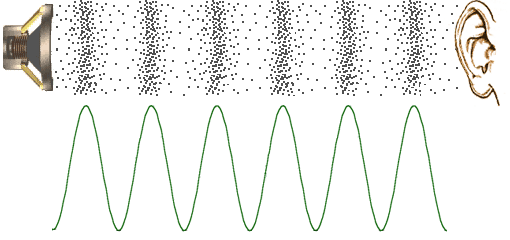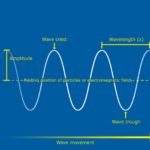As long as your hearing is functioning properly you can hear things around you. What is sound? How does noise travel from an object where it is produced to your ears, so that you can hear it?
Sound is a type of energy that travels through the air, or any other medium, as a vibration of pressure waves. When an object vibrates, it sets the molecules of the medium (the air, water, etc.) around it in motion. These molecules bump into the next set of molecules and so on until the disturbance reaches your ears. The pressure waves cause your eardrum to vibrate, which in turn causes the tiny bones of the middle ear to move. This movement is transferred to the cochlea, a fluid-filled organ in the inner ear. The cochlea is lined with thousands of cells called hair cells. As the fluid inside the cochlea moves, the hair cells are bent. This bending causes an electrical signal to be sent to the brain, which interprets this signal as sound.
There are two main properties of sound – pitch and loudness. Pitch is determined by the frequency of the vibration, while loudness is determined by the amplitude of the vibration. The higher the frequency, the higher the pitch. The greater the amplitude, the louder the sound.
Sound waves are usually described in terms of their wavelength and frequency. Wavelength is the distance between two identical points on a wave (such as two peaks or two troughs). Frequency is the number of waves that pass a given point in a given period of time (usually one second). It is measured in hertz (Hz), which is the number of waves per second.
The human ear can detect a very wide range of frequencies, from 20 Hz to 20,000 Hz (20 kHz). This range gets smaller as we get older – by the time we reach middle age, most people can only hear frequencies up to around 12 kHz.
The loudness of a sound is measured in decibels (dB). The faintest sound that our ears can hear is 0 dB. A sound 10 times as loud would be 10 dB. A sound 100 times as loud would be 20 dB. A sound 1000 times as loud would be 30 dB, and so on.
This loudness is determined by the amplitude of a wave. Amplitude is the height of a wave, measured from the center line to the peak (or trough). The higher the amplitude, the louder the sound.
Sound waves travel at different speeds in different mediums. In air, they travel at around 340 m/s (about 760 mph). In water, they travel much faster – around 1,500 m/s (about 3,330 mph).
When sound waves travel from one medium to another, their speed and wavelength change. This causes the pitch of the sound to change. For example, if you are standing near a fire engine with its siren blaring, you will hear a higher pitch when the vehicle is coming towards you than when it is going away from you. This is because the sound waves are compressed when the vehicle is coming towards you, and stretched out when it is going away.






